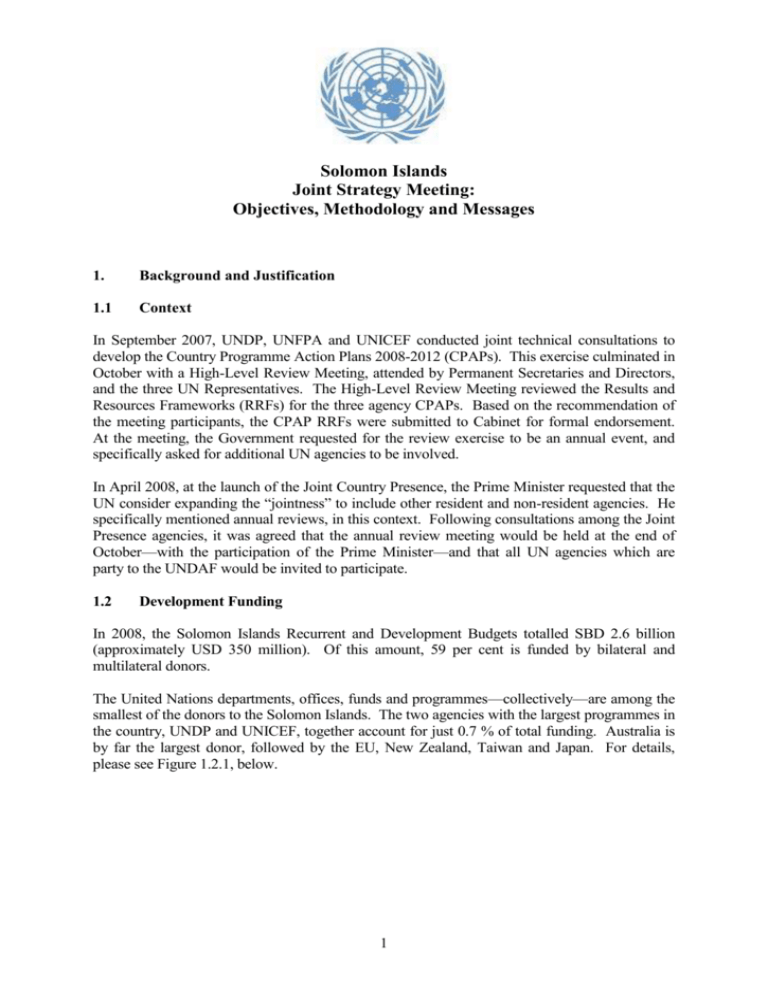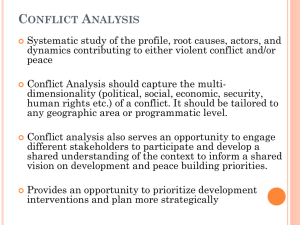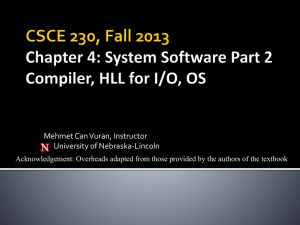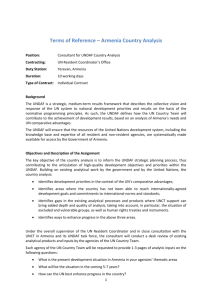Solomon Islands Joint Strategy Meeting: Objectives
advertisement

Solomon Islands Joint Strategy Meeting: Objectives, Methodology and Messages 1. Background and Justification 1.1 Context In September 2007, UNDP, UNFPA and UNICEF conducted joint technical consultations to develop the Country Programme Action Plans 2008-2012 (CPAPs). This exercise culminated in October with a High-Level Review Meeting, attended by Permanent Secretaries and Directors, and the three UN Representatives. The High-Level Review Meeting reviewed the Results and Resources Frameworks (RRFs) for the three agency CPAPs. Based on the recommendation of the meeting participants, the CPAP RRFs were submitted to Cabinet for formal endorsement. At the meeting, the Government requested for the review exercise to be an annual event, and specifically asked for additional UN agencies to be involved. In April 2008, at the launch of the Joint Country Presence, the Prime Minister requested that the UN consider expanding the “jointness” to include other resident and non-resident agencies. He specifically mentioned annual reviews, in this context. Following consultations among the Joint Presence agencies, it was agreed that the annual review meeting would be held at the end of October—with the participation of the Prime Minister—and that all UN agencies which are party to the UNDAF would be invited to participate. 1.2 Development Funding In 2008, the Solomon Islands Recurrent and Development Budgets totalled SBD 2.6 billion (approximately USD 350 million). Of this amount, 59 per cent is funded by bilateral and multilateral donors. The United Nations departments, offices, funds and programmes—collectively—are among the smallest of the donors to the Solomon Islands. The two agencies with the largest programmes in the country, UNDP and UNICEF, together account for just 0.7 % of total funding. Australia is by far the largest donor, followed by the EU, New Zealand, Taiwan and Japan. For details, please see Figure 1.2.1, below. 1 Figure 1.2.1: Sources of Total Funds : 2008 Australia 39.1% EU 6.4% PNG 0.5% Japan 2.5% GEF/ODI/SPC 0.2% NZ 3.8% UNDP 0.4% Other 2.2% UNICEF 0.3% ADB 2.0% World Bank 0.8% ROC 3.2% SIG 40.9% Source: Ministry of Development Planning and Aid Coordination The differences in contribution levels are mitigated somewhat when the “RAMSI effect” is removed from the equation (see Figure 1.2.2, below). However, the UN remains a “niche” player.1 Figure 1.2.2: Sources of Non-Security Development Funds : 2008 EU 14.8% Japan 5.9% PNG 1.1% GEF/ODI/SPC 0.5% NZ 7.8% UNDP 0.9% Australia 37.6% Other 5.0% UNICEF 0.8% World Bank 1.8% SIG 16.9% ADB 4.5% ROC 7.5% Source: Ministry of Development Planning and Aid Coordination 1.3 Commitment to Paris Declaration and Accra Agenda The Solomon Islands is keenly aware of its responsibilities under the Paris Declaration and the Accra Agenda for Action. In order to comply with its Paris Declaration commitment to strengthening country ownership over development, it has developed a Medium Term Development Strategy 2008 to 2010 (MTDS). The Government is using the MTDS to structure its dialogues with all donors—both bilateral and multilateral—and is requiring donors to Government of the Solomon Islands. July 2008. “Medium Term Development Strategy 2008 to 2010,” p. F.9. 1 2 explicitly link their programming to the development priorities and programmes elaborated in the MTDS. Within the development context described in 1.2 above—and in line with the Paris Declaration—the Government is eager to reduce its transaction costs when dealing with the United Nations agencies working in Solomon Islands. It has been a staunch advocate of greater UN coherence, and frequently urges the UN agencies to work more closely together and to use common reporting and planning tools. 2. Objectives The main objective of the high-level review/Joint Strategy Meeting is to obtain high-level endorsement of the UN’s development work in Solomon Islands—including draft annual workplans for 2009—and recognition of the UN’s contribution to the achievement of the Government’s Medium-Term Development Strategy. As one of the Joint Presence countries in the Pacific, the Solomon Islands Government is very aware of the “One UN” agenda and progress in other countries. They are strongly supportive of greater UN coherence, and have consistently lobbied for greater involvement of all UN agencies in joint programming, review and reporting initiatives. Bilateral and multilateral donors are also monitoring the Joint Presence initiative, and have been active in lobbying for greater coordination of the UN agencies working in the country. 3. Methodology The UN Local Team in Honiara2 discussed the proposed annual review at a meeting on 9 July 2008. At the meeting, it was proposed that the annual review exercise be conducted in two stages: Technical review of progress on 2008 AWP and review of draft 2009 AWP; and High-level review of the UN programme. Thirteen United Nations agencies3 have indicated their willingness to participate in the technical reviews and/or the high-level review. Technical consultations are currently under way, and are expected to be completed by 17 October 2008. This will enable time for the participating agencies to revise the documentation on 2008 progress and draft 2009 annual work plans based on the technical review discussions; to create consolidated presentations on the MTDS thematic areas; and to identify overarching issues and risks which will need to be addressed at the high-level session. The high-level review meeting will be held on 30 October. At a meeting on 23 September to discuss the strategy for engaging with Government at the high-level review/Joint Strategy Meeting, the UN Local Team agreed on the following elements: 2 Currently comprising UNDP, UNICEF, UNFPA and WHO. UNDP, UNICEF, UNFPA, WHO, UNESCO, UNIFEM, FAO, UNV, UNIDO, ILO, WMO, OHCHR and UNCDF. 3 3 3.1 Progress reports and 2009 AWPs to be presented according to MTDS categories in order to maximize government ownership of the review process. The relevant development priorities—and sub-categories are: Public Sector Development (UNDAF Outcomes 1, 2, 3 and 4) National Government Provincial Government Reconciliation and Rehabilitation (UNDAF Outcome 2) Reconciliation Cultural Identity Social Services Sector (UNDAF Outcomes 2 and 3) Education Health and Medical Services Economic and Productive Sectors (UNDAF Outcomes 1 and 4) Rural Development Natural Resources Commerce and Trade Land Environmental Protection and Management Civil Affairs (UNDAF Outcomes 2 and 3) Women Youth Children Sports Sector National Disaster Risk Management In addition, a sub-category on “Monitoring” will be included, which will refer to Annex A of the MTDS (UNDAF Outcome 1). 3.2 A “coordinating agency” will coordinate all UN inputs to the different MTDS categories. The coordinating agency will assist the Government to prepare a presentation on the UN’s support to the MTDS for delivery at the Joint Strategy Meeting, and will coordinate with other coordinating agencies to ensure consistency of format, content and style across presentations. The suggested coordinating agencies are: Public Sector Development – UNDP Reconciliation and Rehabilitation – UNDP Social Services Sector Education – UNICEF Social Services Sector Health – UNFPA Economic and Productive Sectors – UNDP Civil Affairs – UNICEF Monitoring - UNDP The suggested coordinating agencies were chosen based on their existing/planned programme in the MTDS category, and also their current status as resident agencies. Coordinating agencies will be responsible for coordinating with all other agencies working within the MTDS category, consolidating inputs into a single presentation on behalf of all United Nations agencies. The UN Local Team is currently discussing with the Government whether Government ministries will deliver the presentations at the high-level review/Joint Strategy Meeting. This 4 was proposed in 2007, but the Government declined (the UN agencies did the presentations). It is hoped that with greater familiarity with the review mechanism, the Government will this year agree to do the presentations. 3.3 Joint presentation on implementation issues4 and risks5 Through review of past and future UN annual workplans, a number of existing and future risks and issues impacting implementation will be highlighted. During the technical consultations, the participating Government departments and UN agencies will identify and discuss these risks and issues. In the week between the technical consultations and the highlevel review, these risks and issues will be grouped and consolidated in order to identify the 3-5 risks/issues with the greatest potential impact on the implementation of UN programmes. These risks/issues will then be discussed at the high-level review meeting, and consensus will be reached on strategies for mitigation and remediation. The draft agenda for the high-level review/Joint Strategy Meeting is attached herewith as Annex A. 4. Messages Due to the one-day format of the Joint Strategy Meeting, and to the number of UN agencies which will be participating in the event, it will be necessary to agree in advance on common messages and themes which will be touched on in the presentations. Some suggestions include: The UN is supporting the Government to implement the MTDS. The UN is helping the Government to attain the MDGs (both global and national MDGs). The UN is helping the Government to meet its international treaty obligations (Kyoto Protocol, Convention on the Rights of the Child, etc.) The UN links the Government to global expertise, and the experiences of other countries in similar development situations. The UN is working toward greater coherence in the Pacific. Wherever possible, issues will be raised or statements will be made “on behalf of the United Nations system”, rather than as the position of individual agencies. 5. Expected outputs of the exercise Expected general outputs of the high-level review/Joint Strategy Meeting are the following: 1) High-level endorsement of 2008 progress reports and draft 2009 annual workplans. “Issues” are defined as unsettled matters—often under discussion or in dispute—or matters on the verge of decision. For instance, an issue might be the source of Government funding for the “Free Basic Education for All” programme post- 2012, when logging revenue is expected to decline sharply. This decision will affect UN programming in the education sector. 5 “Risks” are defined as the chance that a situation will result in a loss or hazard. For example, the risk that programme implementation will be delayed due to a lack of technically qualified consultants, or the risk that a certain percentage of vaccines will spoil due to lack of electricity in provincial health centres. Either of these would affect the UN’s ability to deliver on its programmes. 4 5 2) Recommendations related to remediation of and/or preparation for “risks” and “issues” associated with the implementation of UN programmes. 3) High-level endorsement of (or recommendations on) the draft UNDAF Monitoring and Evaluation Framework. An expected output specific to the UN is the following: 4) Contribution to the UNDAF Outputs and Outcomes Annual Report. 6 Annex A AGENDA Joint In-Country Annual Review High-Level Review Meeting 30 October 2008, Mendana Hotel 08:30 Opening Prayer and Welcome Remarks Mrs. Jane Wa’etara, Permanent Secretary, MDPAC 08:50 Remarks on behalf of the United Nations agencies in the Pacific Mr. Richard Dictus, UN Resident Coordinator and UNDP Resident Representative 09:10 Remarks on behalf of the Ministry of Development Planning and Aid Coordination Honourable Minister Steve Abana 09:30 Keynote speech on UN-Solomon Islands Cooperation Honourable Prime Minister Dr. Derek Sikua 10:00 Coffee Break 10:30 The UN’s contributions towards the Medium-Term Development Strategy Governance at National and Provincial Levels Reconciliation and Rehabilitation Social Services Sector – Education Social Services Sector – Health Economic and Productive Sectors Civil Affairs 12:00 Lunch Break 13:00 Presentation and discussion on implementation issues and risks 14:30 Tea Break 15:00 UNDAF Monitoring and Evaluation Framework Mr. Najib Assifi, UNFPA Representative and Director of Country Technical Services Team 16:00 Session wrap-up and next steps 17:00 High-Level Review Meeting closes Master of ceremonies: Mr. Allan Daonga, Director of Aid Coordination, MDPAC 7






